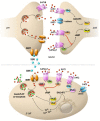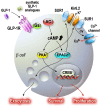Unlocking Therapeutic Synergy: Tailoring Drugs for Comorbidities such as Depression and Diabetes through Identical Molecular Targets in Different Cell Types
- PMID: 38067196
- PMCID: PMC10706795
- DOI: 10.3390/cells12232768
Unlocking Therapeutic Synergy: Tailoring Drugs for Comorbidities such as Depression and Diabetes through Identical Molecular Targets in Different Cell Types
Abstract
Research in the field of pharmacology aims to generate new treatments for pathologies. Nowadays, there are an increased number of chronic disorders that severely and durably handicap many patients. Among the most widespread pathologies, obesity, which is often associated with diabetes, is constantly increasing in incidence, and in parallel, neurodegenerative and mood disorders are increasingly affecting many people. For years, these pathologies have been so frequently observed in the population in a concomitant way that they are considered as comorbidities. In fact, common mechanisms are certainly at work in the etiology of these pathologies. The main purpose of this review is to show the value of anticipating the effect of baseline treatment of a condition on its comorbidity in order to obtain concomitant positive actions. One of the implications would be that by understanding and targeting shared molecular mechanisms underlying these conditions, it may be possible to tailor drugs that address both simultaneously. To this end, we firstly remind readers of the close link existing between depression and diabetes and secondly address the potential benefit of the pleiotropic actions of two major active molecules used to treat central and peripheral disorders, first a serotonin reuptake inhibitor (Prozac ®) and then GLP-1R agonists. In the second part, by discussing the therapeutic potential of new experimental antidepressant molecules, we will support the concept that a better understanding of the intracellular signaling pathways targeted by pharmacological agents could lead to future synergistic treatments targeting solely positive effects for comorbidities.
Keywords: cell signaling; channel; depression; diabetes; pharmacology; receptor.
Conflict of interest statement
The authors declare that they have no known competing financial interests or personal relationships that could have appeared to influence the work reported in this paper.
Figures




Similar articles
-
Galanin receptor antagonists : a potential novel pharmacological treatment for mood disorders.CNS Drugs. 2006;20(8):633-54. doi: 10.2165/00023210-200620080-00003. CNS Drugs. 2006. PMID: 16863269 Review.
-
Other Antidepressants.Handb Exp Pharmacol. 2019;250:325-355. doi: 10.1007/164_2018_167. Handb Exp Pharmacol. 2019. PMID: 30194544
-
The effect and mechanism of Jiao-tai-wan in the treatment of diabetes mellitus with depression based on network pharmacology and experimental analysis.Mol Med. 2021 Dec 7;27(1):154. doi: 10.1186/s10020-021-00414-z. Mol Med. 2021. PMID: 34875999 Free PMC article.
-
New trends in the neurobiology and pharmacology of affective disorders.Pharmacol Rep. 2013;65(6):1441-50. doi: 10.1016/s1734-1140(13)71504-4. Pharmacol Rep. 2013. PMID: 24552991 Review.
-
A systematic review of the antidepressant effects of glucagon-like peptide 1 (GLP-1) functional agonists: Further link between metabolism and psychopathology: Special Section on "Translational and Neuroscience Studies in Affective Disorders". Section Editor, Maria Nobile MD, PhD. This Section of JAD focuses on the relevance of translational and neuroscience studies in providing a better understanding of the neural basis of affective disorders. The main aim is to briefly summaries relevant research findings in clinical neuroscience with particular regards to specific innovative topics in mood and anxiety disorders.J Affect Disord. 2019 Oct 1;257:S0165-0327(19)30593-2. doi: 10.1016/j.jad.2019.05.044. Epub 2019 May 28. J Affect Disord. 2019. PMID: 31153593
References
-
- Delgado P.L. Depression: The case for a monoamine deficiency. J. Clin. Psychiatry. 2000;61((Suppl. S6)):7–11. - PubMed
Publication types
MeSH terms
Substances
LinkOut - more resources
Full Text Sources
Medical

